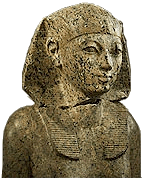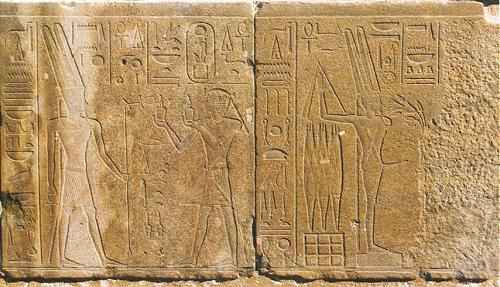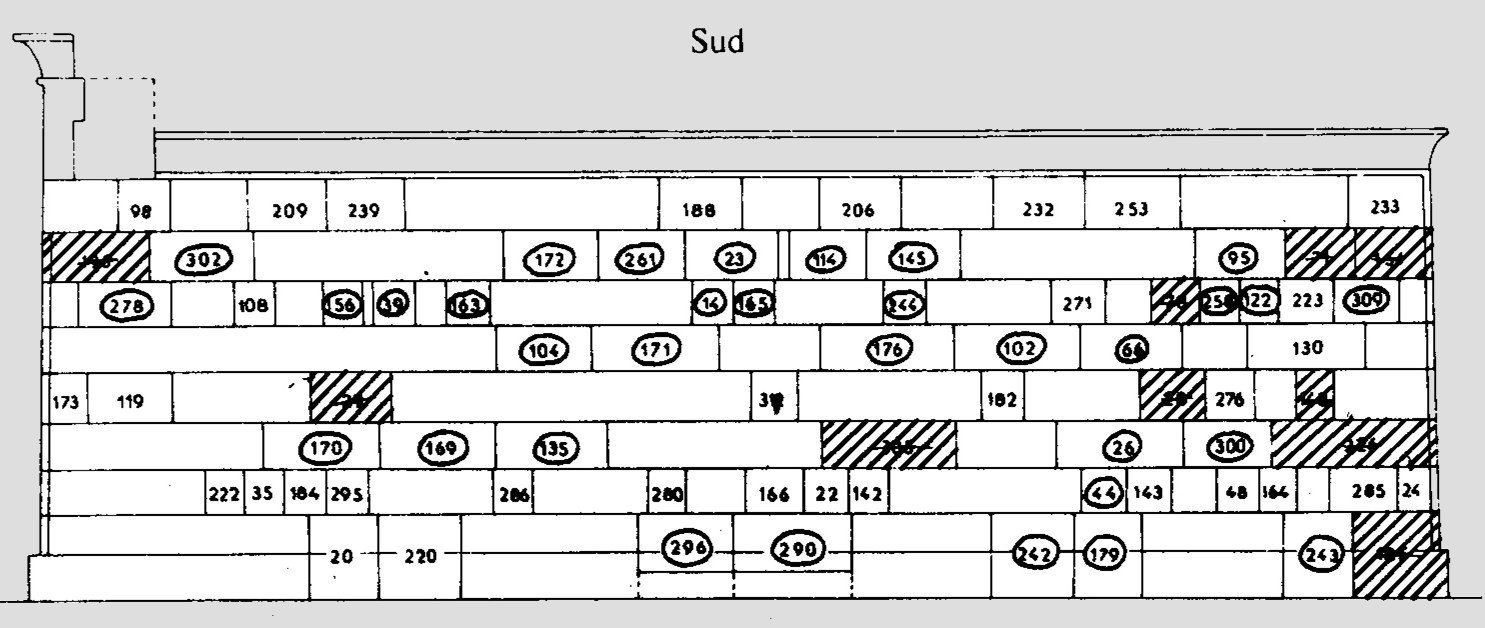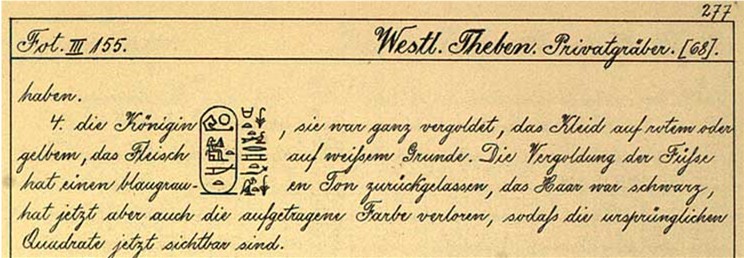|
Maat-ka-Ra Hatshepsut |
last update: 25.03.2008 |
End and Persecution
 |
Maat-ka-Ra Hatshepsut (on the left the upper part of a seated statue, which is today on show in the Metropolitan Museum, New York) governed Egypt for more than 20 years. In the last years her designated successor, Thutmosis III., had stepped out from her shadow and had probably taken over more and more official functions. As a commander in chief of the army he had apparently led the expeditions to the Sinai (year 13 and 16), the campaign against Nubia (year 20), and the campaign against Maau (year 20-22?). Sometime between years 20 - 23 also the town Gaza was conquered (in the year 23 described as a town which already had been conquered) whether this took place still during lifetimes of Hatshepsut or briefly after her death is uncertain, however, during this campaign Thutmosis III. might have had the military command. |
|
According to Tyldesley (1996) the Horus Maat-ka-Ra Hatshepsut climbed to the sky after 22 years and 6 months of reign. This might be cum grano salis applicable, since also Manetho who wrote a history of Egypt at the beginning of the 3. century B.C. attested for a queen called AmessÍs who was the 4. ruler of the 18. dynasty a reign of about 21 years and 9 months. There are no hints that the death of Hatshepsut was connected with any disturbances or had been somehow unnatural. |
| There are also no hints that Thutmosis III had neglected his obligations as the successor towards her. Only remarkable is the change in his throne name, Men-cheper-ka-Ra (Enduring is the Appearance and the Ka of Ra), which was changed in Men-cheper-Ra (Enduring is the Appearance of Ra). Therefore, we can assume that Thutmosis III got mummified Hatshepsut according to her rank and finally buried her beside her father in KV20. |
| Persecution of Hatshepsut Indisputable it is however that sometime after the death of Hatshepsut Thutmosis III began with the persecution of her memory ("Damnatio memoriae"). In this connection he built a new tomb for his grandfather, Thutmosis I, and finally re-buried him there. This tomb, KV38, confused a little bit the Egyptologists at the beginning of its discovery. It contained a yellow sarcophagus made of quartzite (today on show in the museum at Cairo), inscribed for Thutmosis I. Therefore, it was regarded as his original tomb built by Ineni who himself gave report about it. Only in 1974 Romer pointed out (according to Reeves, Wilkinson , 1997) that the layout of KV38 resembles so much of the architecture of KV34 (tomb of Thutmosis III) that both tombs must have built at the same time. Therefore, the tomb built by Ineni had to be searched elsewhere (probably KV20). The devastations arranged by Thutmosis III at the buildings of Hatshepsut had been already addressed in their description, thus, the Red Chapel should be mentioned only as an example. However, until today the subject of the academic discussion is the question "when did he start with the persecution of Hatshepsut". |
|
At the beginning it was assumed that Thutmosis III started with the
persecution of her memory immediately after the death his "hated" stepmother
Hatshepsut who had kept him away from power for 20
years. However, this cannot be brought in line with newer architectural
investigations, particularly in the temple district of Karnak. The investigations of the so-called "Chambers or Suite of Hatshepsut" on the right of and left of the sanctuary (its center was previously the Red Chapel) showed that the - however incomplete - deletions of her name had been done during the reign of Thutmosis III but probably rather late in his reign. |

| The photo above shows a part of the unpublished relief of the "Chambers or Suite of Hatshepsut"; Hatshepsut, one the right side, is shown sacrificing in front of the ithyphallic Amun (left); above her the two cartouches of Maat-ka-Ra Hatshepsut are easily to be deciphered. |
|
Above all, the fact that Thutmosis III finished the Red Chapel (3 scenes of the 7. and the entire 8. register, according to Meyer, 1989) - and of course usurped the building - argues against a procedure full of hate and in the opinion of several scholars also against a start of the persecution immediately after her death. |
|
Various inscriptions at Karnak seem to lead to at beginning of her
persecution late in the reign of Thutmosis III. Starting point is the dating of the inscription regarding the youth of Thutmosis III ("Text de la Jeunesse") at the southern exterior wall of the central building of Hatshepsut in the temple of Amun at Karnak. Borchardt and Sethe (quoted after Meyer,1989 ) dated this inscription into the regnal year 42 of Thutmosis III or even later, since the "Text de la Jeunesse" mentions the Hall of Annals built by Thutmosis III.. Vice versa, the Hall of Annals itself mention regnal year 42 as the highest date, i.e. the "Text de la Jeunesse" must have been attached after the Hall of Annals had been erected. In addition, also the Red Chapel of Hatshepsut mentions the "Text de la Jeunesse" which suggests apparently, that the Red Chapel still existed at the time of the attachment of the inscriptions. |

| Also the incomplete and non-systematical destruction on the blocks of the Red Chapel (see photo above: in the right register cartouche and figure of Hatshepsut are destroyed, in the left register both are preserved) was frequently discussed in connection with the proscription of Hatshepsut. |
| The distribution of the blocks concerned (see below the schematic representation of the south wall) was interpreted by Meyer, 1989, in that way that the destruction was accomplished at the still standing chapel. If the destruction would have taken place after the dismantling, then - in her opinion - most likely the destruction would have affected the majority blocks from the lower registers or those from an individual wall been, since with the dismantling and storage of the blocks those from the upper registers would have been stored below others and, thus, would have been inaccessible. |

| South side of the red chapel (schematic); the blocks with a number show the intact figure of Hatshepsut, on the dashed blocks her figure were deleted (Institut FranÁais d'Archťologie Orientale; according to Dorman, 1988) |
| However, the fact that Thutmosis III had finished the Red Chapel and passed the chapel in the "Text de la Jeunesse" as his own building does not exclude that the persecution of Hatshepsut had already started during the decoration of the last blocks in registers 7 and 8. According to Meyer the inconsistent erasures on the blocks suggests that the still standing chapel should be "re-dedicated" to Thutmosis, but in the long run the chapel had been taken down due to technical problems. Thus, the destruction of the traces of Hatshepsut at the Red Chapel could have begun quite a long time before the aforementioned year 42 (see also the page about the Red Chapel). |
| The aforementioned year 42, however, would be in line with the fact that Thutmosis III had dismantled the Red Chapel and replaced it by a new bark shrine. From this bark shrine a decorated fragment had survived that contains the date "year 46" (van Siclen "The Date of the Granite Bark Shrine of Thutmosis III" GM 79, 1984; quoted after Meyer). If the erection of the bark shrine of Thutmosis III did start not long after the Red Chapel had been dismantled - this can be guessed only -, then the time between year 42, in which the Red Chapel was most likely still intact (see above), and year 46 would be sufficient for taking down the Red Chapel and start with a new building. |
| The attempt to deduce a date for the beginning of the
persecution of Hatshepsut from dismantled buildings and destroyed or undestroyed
relief is - at present - probably doomed to failure. At the time there
is nothing to be said (see also Meyer, 1989) against the assumption that
the persecution of Hatshepsut had begun early after her death: - for example, in the "Festival Hall (Akh menu)" of Thutmosis III (commencement of construction: year 24) architrave of sandstone from an - unknown - building of Hatshepsut got reused as paving-stones and had been inserted in such a way that her titles were hidden. However, one can not definitely infer a persecution of Hatshepsut from the fact that one of her buildings was taken down - a lot of other kings before and after Thutmosis III have torn off buildings of their predecessors in order to receive place them by own monuments. - likewise in the temple of Ptah limestone blocks with the titles of Hatshepsut were discovered which originate from a building that Thutmosis III had taken down. Since the donations of Thutmosis III for the temple of Ptah mention his return from his first campaign to Syria (year 23) as the highest date this may also point to an early beginning of the persecution of Hatshepsut. - the two obelisks erected by Hatshepsut between pylons 5 and 6 were walled-in when Thutmosis III rebuilt the central area of the temple. On the encased lower parts of the obelisks intact representations of Hatshepsut had survived while on the upper parts which were not walled-in her traces had been erased - except those on the tip. The assumption that her persecution had not been started before the lower parts were walled-in can be easily refuted by the argument that it had not been necessary to destroy her traces on the lower parts - since they would not to be seen anymore. Obviously, one also abandoned to erase her traces on the blocks of the Red Chapel after the chapel had bee taken down. |
| In the opinion of Eaton-Kraus (1998) newer findings of Loeben
(published later in 2001) on the statues in front of the 8.
Pylon (see also "8.
Pylon") at Karnak temple which had been erected by Hatshepsut
point to an early beginning of her persecution: In front of the pylon there are two seated giant-statues of limestone both showing a "renewal text" dated into year 22 of Thutmosis III, one is assigned to Amenhotep I. (Djoser-ka-Ra) and the other to Thutmosis II (Aa-cheper-en-Ra). According to Loeben both statues which originally represented Hatshepsut had been spared by Thutmosis III from her persecution because of their impressing feature and got reassigned by him in favor of his ancestors According to Eaton-Kraus this would indicate the earliest date of her persecution. However, Loeben himself does not follow this conclusion because he considers that it is quite possible that Thutmosis III "antedated" his inscriptions. Moreover, he points to the possibility that the inscriptions had been "antedated" by the successor of Thutmosis III, Amenhotep II, in the name of his father. This argument can hardly by dismissed especially in the view of the fact that Amenhotep II has given this pylon his special interest - as demonstrated by the decoration. |
| Of course there still further arguments of that kind
which can be put together either to support an early or a late persecution of Hatshepsut. Perhaps the autobiography of Ahmose Pennechbet
gives the "correct" reference. In this autobiography which was written briefly after the death of
Hatschepsut i.e. at the
beginning of the reign of Thutmosis III., he wrote:
"I have accompanied the kings of Upper and Lower Egypt, the Gods (=
the meanwhile deceased of kings), under which I lived, on their
campaigns in southern and northern foreign countries, at each
place, to which they have gone, the King of Upper and Lower Egypt "Neb-pehti-Ra" (Ahmose
I), the blessed one, the
King of Upper and Lower Egypt "Djeser-ka-Ra" (Amenhotep I), the blessed one, the
King The God's Wife repeated favors for me, the Great King's Wife "Maat-ka-Ra" (Hatshepsut), justified; I educated her eldest daughter, Neferu-Ra, justified, when she was a child at the breast." (quoted after Dorman, 1988; Grimm, Schoske, 1999) . Not only that Ahmose Pennechbet enumerates the legitimate sequence of the kings he had served he also mentions the deceased illegitimate king Hatshepsut but only with her queenly titles "God's Wife" and "Great King Wife". The king Maat-ka-Ra whom he had served so long he suddenly did not exist anymore. Enumerating the legitimate sequence of the predecessors of Thutmosis III indicates (see also Tyldesley, Meyer) the reason for the persecution of Maat-ka-Ra Hatshepsut. The deletion of her representations and cartouches in connection with the use of his own name as well as that of his father and his grandfather proves Thutmosis III as a direct and legitimate successor in the male line of the Thutmosid kings. - probably more a political necessity (all have no royal blood in the veins) than a personal revenge! Probably, the reason might have been rather a political necessity, than a personal revenge! Possibly, it was intended to correct the "genealogic" succession of kings (maybe, a succession from Thutmosis I. via Thutmosis II to Thutmosis III was "optically better", because all had no royal blood in their veins), possibly, it was intended to extinguish the reign of Hatschepsut from the annals because it was "not in conformity with the Maat". But a differentiation between both potential reasons is not possible - since one also causes the other. |
| Now and then, there is a remark concerning an ongoing "admiration" of Hatshepsut during the reign of the successors of Thutmosis III. As a rule, the representation of a group of statues in the tomb of Kenamun (TT 93, see also Porter&Moss, Vol. I-1) is used as a reference (e.g., from Schulze, P. H. in " Mistress of the Two Lands", Bergisch Gladbach in 1980 to which then others refer). |
| In this tomb, the western wall of the transversal hall shows left from the passage which leads to the burial chamber in the first of 4 registers the representations of gift bringers and statuettes of Amenhotep II, Hatshepsut, and Thutmosis I (according to Porter&Moss). Without making the effort to check the sources Hatshepsut is equated with queen Hatshepsut-Khenemet-Amun and it is told that her name would be mentioned also in a cartouche. Already Ratiť (1979) pointed out that beside the cartouche the title of a "Mother of the King (mwt nsw) " was shown - a title which had never been attributed to her. Really, a look into Lepsius "Monuments" (Vol. III, text to private tomb no. 68 = tomb of Kenamun, No. 93 in Porter&Moss, I-1, page 190) shows that the cartouche contains the name of the mother of king Amenhotep II - H3t Sps.t-mr.t ra (see also the following picture from Lepsius). |

| The inscriptions right of the cartouche reads "His beloved Great Queen, Mother of the King (=Hm.t nsw wr.t mr.t=f |mwt nsw). |